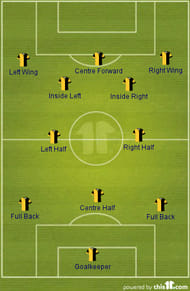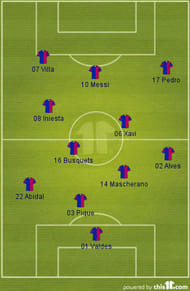England manager Roy Hodgson warms up with the team during an England training session during UEFA Euro 2012. Hodgson has been slowly and steadily tinkering with the English set-up. (Photo by Scott Heavey/Getty Images)
Since the idea first came about over a hundred years ago, managers and coaches have tinkered with formation and tactics, shuffling their players around the pitch, responding to weaknesses as a chess grand-master would do with his pieces, looking to gain that slightest of advantages that may lead to victory.
In 1925, football in England had become a dull, stale affair with few goals being scored and attendances consequently falling. In response, the FA proposed a change to the offside law of the day, advocating a reduction in the number of defending players required to be between the goal and the attacker from three to two. The previous law had inadvertently nullified attacking play, allowing teams to push one of their defenders up to try and catch an attacker offside, but leaving another back as cover.
The new proposal would mean the removal of the covering defender when playing offside and theoretically liberalise attacking play. The Scottish FA adopted the new law as well and presented it to the International Board, with the new amendment being implemented worldwide ahead of the 1925-26 season.
Goals did indeed increase, but at a cost. The new offside law meant forwards had more room to move, utilising more of the pitch and leading to short passing giving way to longer, direct balls. Indirectly, it also led to the redeployment of the creative-style centre-half to a deeper, more defensive role, splitting the two fullbacks and creating a third back – which we now know as a centre-back.
As attacking formations continued to develop, so too did tactics at the back. Three at the back became four and, England, pragmatic as ever, has adopted this as the norm ever since.
Similarly, rule changes and modern pressing of play up front led to the need to control possession; five forwards became two, latterly developing to a single striker and perhaps in some cases, no recognised centre forward at all.
When Spain lifted their third consecutive international trophy – winning their second European Championships, they did so by playing the majority of the tournament without a recognised forward, with Barcelona‘s Cesc Fàbregas as a ‘False 9′ instead. The formation created extra bodies in midfield, allowing them to control possession and create chances by positional interchanging and late runs into the box.
As has been the case historically with all successful previous tactics, the rest of the footballing world has looked to follow suit, and the sight of two out-and-out forwards playing together has become rare, seemingly outdated and easily riposted.
The question is – what does this mean for our traditional four at the back? If the opposition is playing with at most one forward, is a second centre-back not left redundant, acting simply as extra cover, sitting back with no one to mark, and ultimately wasted?
For years, English football has found itself bamboozled time and again by forwards who sit between the lines of midfield and attack. Previously, this type of player had sat behind two centre-forwards, requiring the attention of the two central defenders and leaving a midfielder to act as the spare man defensively. As one of those centre-forwards has been disposed of in most modern attacking line-ups, would it not make more sense to move one of the centre-backs higher up the pitch to mark the player between the lines, freeing up the midfielder to become more involved with attacking play and creating a loose 3-4-3 formation?
A similar formation has been used previously of course: the classic Italian-style sweeper system. But instead of two markers and one sweeper to carry the ball out of defence, the formation would be reversed, with just one defensive marker and two deep-lying players with freedom to join the attack.
In his final season at Barcelona, Pep Guardiola was developing something similar, utilising the system in the 2011 Champions League final win over Manchester United. In that instance, Gerard Piqué acted as the single centre-back, with Javier Mascherano and Sergio Busquets rotating in and out of the other central defensive role. It should be noted that the two full-backs were not charged with extra defensive responsibility, with Dani Alves in particular a constant attacking threat on the night. Manchester United’s classic 4-4-2 formation was well-beaten, unable to wrestle possession back from Barcelona and being completely overrun in midfield.
The opportunity is there at the moment for English football and its national side to potentially get ahead for once. As a nation it is surprising that we have never been remotely close to adopting anything like a sweeper system.
The modern sweeper role has always felt an ideal fit for the classic, but slightly outdated English-style centre-midfielder. Steven Gerrard for instance, combines an excellent range of passing and good defensive capabilities with the stamina required to burst forward from deep to begin attacks.
With this in mind it was both encouraging and frustrating to hear Roy Hodgson talk up the possibility of using Michael Carrick in a similar role in the recent friendly with San Marino, only for that classic English pragmatism to take hold and the idea being scrapped. However, at least Hodgson acknowledged that because of the perceived lack of threat from the opposition, creating an extra attacker would be beneficial and it’s a role the England manager wouldn’t be short of potential players to fill – with Phil Jones and Jack Rodwell as well as the aforementioned Gerrard and Carrick ideally suited.
Changes to formation will continue to develop as long as football exists. Throughout the history of the game, English football has always been slow to react, stubbornly sticking to its guns, relying on physicality and athleticism to combat the tactically forward-thinking coaches from outside football’s ‘spiritual home’.
In Hodgson though, England unexpectedly appear to have a coach willing to at least consider moving away from the system that has served him so well throughout his career. England need more than their fair share of fortune to do well at the World Cup in Brazil if they qualify.
The country does have talent coming through, but if it is to compete when the European Championship circus rolls up in France in 2016, it needs to develop a system that will allow the team to compete for and retain possession. Without doubt, that would require a move away from the out-dated, unambitious and ultimately unsuccessful two banks of four.


